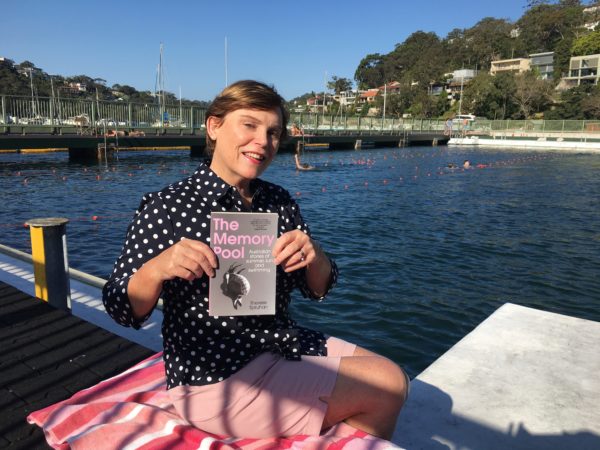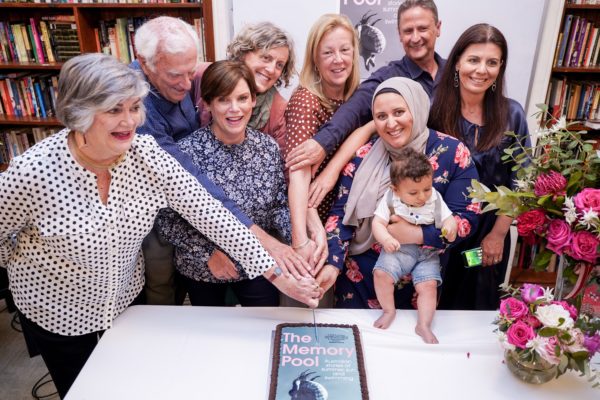Each month we shine our spotlight on a member of the Writing NSW community to learn more about their writing journey, achievements, and inspirations. This month we spoke with Therese Spruhan, author of the newly-released anthology of short stories, The Memory Pool: Australian stories of summer, sun and swimming.
Therese is an avid swimmer, writer and photographer from Sydney’s Inner West. She chronicles pools, swimmers and places to swim through her blog, Swimming Pool Stories, travel articles for the The Weekend Australian and other writings for anthologies, online and print publications. The Memory Pool is her first book and was published with NewSouth in November of this year.
Our Membership and Administration Officer, Lou Garcia-Dolnik, spoke with Therese about the inspirations and motivations behind the text, and her experience working with publishers and editors on the path to publication.
Congratulations on the recent publication of The Memory Pool with NewSouth Books–what fantastic news! Can you speak to the inspiration behind choosing the pool as the focal point of the anthology?
Thank you! It’s been an exciting year having my first published book. I chose the pool as the focal point of the anthology because I wanted to celebrate the pool in Australian life. I was also interested in the pool as a setting for revealing stories about people, place and Australia. I decided to focus on childhood memories as that’s when we have our most intense connection with it.
Another inspiration was wanting to show the complexity of our relationship with pools as much more than places where we learn to swim and cool off in summer. As people will see when they read the stories, the pool has inspired imaginations, built courage, fulfilled dreams, provided a refuge and, for some, has been a type of church.
As author Trent Dalton explains in his story, ‘Sprinting to the Sandgate swimming pool’, ‘I didn’t go to church as a kid but that was my church–my sacred space–a pilgrimage to the Sandgate swimming pool. That’s where I was always going as a kid.’
What were some of the formative experiences you had around the pools of your childhood that sparked your initial curiosity in it?
Northbridge Baths, a tidal pool on Sydney’s Middle Harbour was a very important place in my childhood, like a best friend. Right from the beginning I loved being in the salt water at the baths, the physicality and freedom of swimming, and often had that feeling of never wanting to get out. Other formative experiences revolved around the swimming club and competing in the Saturday morning races, underwater handstands, Paddle Pops and Redskins, the slimy jellyfish that floated in and the occasional man o’ war (the only thing I was scared of at the baths).
Another key memory that comes to mind is being at the baths with my family when the glorious king tide flowed in and feeling euphoric in the crystal clear water spilling over the blocks and concrete steps in the shallows.
Other times we’d knock on the neighbours’ doors and ask if we could swim in their backyard pool. During high school, I loved our annual school carnivals at iconic North Sydney Olympic Pool, which also featured an inter-house, extravaganza water ballet event which we spent weeks practising for. Since those childhood days, swimming and pools have continued to be constants in my life.
What motivated your decision to interview such an eclectic group of (professional and non-professional) swimmers?
 My aim was to feature a diverse range of Australians across the country in a variety of different pool settings–sea, bay, river, chlorine and backyard. I wanted to include some well-known Australians as I felt their stories would attract readers to the book. In the end, about 12 prominent Australians said yes to taking part in the book, including Bryan Brown, Leah Purcell, Trent Dalton, Ashley Hay and Merrick Watts.
My aim was to feature a diverse range of Australians across the country in a variety of different pool settings–sea, bay, river, chlorine and backyard. I wanted to include some well-known Australians as I felt their stories would attract readers to the book. In the end, about 12 prominent Australians said yes to taking part in the book, including Bryan Brown, Leah Purcell, Trent Dalton, Ashley Hay and Merrick Watts.
I also interviewed three swimming champions–Shane Gould, Daniel Kowalski and Priya Cooper, as well as former Australian swimming coach Laurie Lawrence. It’s wonderful to have their experiences featured in the book, but their stories are less about their achievements and more about their relationship with a childhood pool, training, friends, and their journey towards swimming success. There are also stories from artists, musicians, nurses, an academic, a priest, a former politician, a lawyer, a naturopath, and others aged from 28 to 97.
How long did it take to tease your ideas, interview transcripts and drafts into one, cohesive text?
Before I had the publishing contract with NewSouth Publishing, I spent a month or more working on each story, from preparing questions for the interview, transcribing the interview, writing a first draft, and then numerous drafts after that. Once I’d signed the contract with NewSouth I had a very tight deadline to finish the rest of the book, so from then on, each story took about a week to complete after I’d done the interview.
The process of transcribing each interview was useful in getting a sense of where the heart of each story was. After re-reading the transcript, I wrote each story in long-hand as I found that was the best way to ensure it flowed. The next step was typing up that first draft and then going back through the transcript to add sentences, words or phrases that each person had used in their interview. I also wrote a short introduction for each story to set the scene.
How did you manage to craft the disparate voices of the people you interviewed, keeping in mind the diversity and uniqueness of their experiences?
Mainly by writing each story in first person and making sure I stayed true to what they had told me in the interview. I also made sure to use the particular words, expressions and phrases of the interviewee. For instance, when Laurie Lawrence talked about his parents separating when he was 15, he didn’t say they broke up or got divorced, he said, ‘they parted ways’, so I made sure I used those exact words in order to make the story sound like it was being told from his voice.
I was very conscious of giving the reader a strong sense of the person telling the story through their interaction with the pool, an image of what the pool looked like and a sense of the surrounding space. It was also very important to me that each of the stories was not simply about the pool, but also revealed something about human experience. For example, in 97-year-old Merv Knowles’ story of growing up at Canberra’s Manuka Pool, the loss of his much-loved older brother Lindsay who died in World War Two is always present. Weaving through former Tasmanian premier David Bartlett’s story are struggles with his identity as a result of being adopted and the backyard pool as his refuge.
What was the process like finding the right publisher for your book?
Perhaps a bit random and serendipitous too. In the end, I found my way to NewSouth Publishing when another publisher rejected The Memory Pool with the parting words that they felt my ‘social history’ was better suited to NewSouth. It was an interesting comment as, earlier on in the writing of the book, I had identified NewSouth as one of three publishers that The Memory Pool might be a good fit with. With encouragement from Bronwyn Birdsall, who I share a writing space with at Writing NSW, I followed up with NewSouth. A few weeks later I met with NewSouth publisher Philippa McGuinness and, in early February 2019, I was offered a contract to publish The Memory Pool: Australian stories of summer, sun and swimming.
What was it like to receive editorial input from such a large and well-renowned publisher as NewSouth?
Throughout the many stages of publication, the wonderful team at NewSouth were always very enthusiastic about The Memory Pool. In particular, publisher Philippa McGuinness, my project editor Emma Hutchinson and publicity manager Harriet McInerney have always been encouraging, supportive and calm. Working with my editor Linda Funnell was also a very positive and collaborative experience. Linda’s editing was very thoughtful and I particularly liked her comment that there was a lot of love woven through the stories in the book.
The launch of The Memory Pool was held at Writing NSW on Friday 1 November. In her opening address, NewSouth Publisher Philippa McGuinness suggested that ‘the new thing to say at social events is to ask people where they learnt to swim’. What is it, do you think, about the pool that draws people together, despite cultural, geographic and generational differences?
I think John McSweeney, one of the 28 people featured in my book, answers that question well. He says of Melbourne’s Brighton Baths: ‘I always say it’s a place where nobody matters but everybody matters–you can be the judge of the county court or you can be the local garbage man and no one would have a clue when they’re all down there because they all mix and mingle.’
I think some of the pretence of everyday life is stripped back at the pool where we’re all in our swimmers. That’s what I’ve always liked about the pool. There was always such a diverse group of people at the Northbridge Swimming Club when I was kid, including a local GP, electrician, as well as a mix of young people from all the different local schools. It’s the same democratic atmosphere as Petersham’s Fanny Durack Aquatic Centre where I now swim each morning and have become friends with many of the regulars after stopping for a chat at the shallow end.
We’re keen to hear about what you’ve been working on since publication of the anthology. Can we expect more pool stories from you in the near future?
I definitely have more ideas for telling stories about pools, whether that’s on my blog, Swimming Pool Stories, or in the pages of a book. I also enjoy writing fiction and so, hopefully when this busy stage of publicising The Memory Pool slows down, I’ll return to a short story or two, perhaps with an aquatic theme.
*
About the Writer
Therese Spruhan is a Sydney-based swimmer, writer and photographer with a passion for telling stories and capturing images of Australia’s pools. She writes about pools and swimmers on her popular blog Swimming Pool Stories and about places to swim in travel articles for The Weekend Australian. In 2016 she was a contributor to the book, The Pool: Architecture, Culture and Identity in Australia, and to the broadsheet, From the Edge, which accompanied Australia’s exhibition, The Pool at the 2016 Venice Architecture Biennale. Therese’s stories and photos were also featured in a digital newspaper when The Pool was re-exhibited at the National Gallery of Victoria in 2017–2018. Her first book, The Memory Pool: Australian stories of summer, sun and swimming, was published on November 1 2019 with NewSouth.


